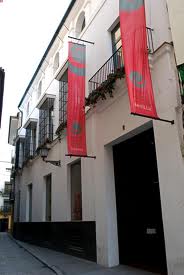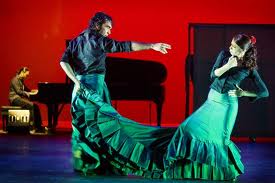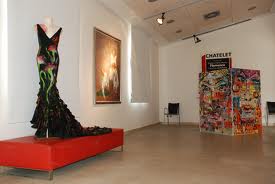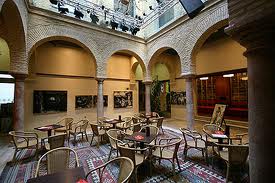Flamenco Museum

Where: Calle Manuel Rojas Marcos 4, 41004
Opening hours: Monday to Sunday from 10 am to 7 pm
Flamenco
Flamenco is a music and dance genre originated in the Spanish region of Andalucía in the 13th century. There are many controversies regarding its genesis, with many versions and opinions giving different accounts, none of which, however, can be historically proven. Some say it's related to the gypsy ethnicity. This is apparently not possible when it comes to flamenco's origins, however no one doubts their contribution to the foundations of flamenco. Spaniards are generally associated with flamenco abroad. However, when you visit Spain you will realise that, while flamenco can be seen everywhere in the country, it really originated here, in Sevilla, in Andalucía.
The most accepted hypothesis is that flamenco could only have sprung from the blend of races and cultures specific to the region (Jews, Christians, Gypsies and Muslims), which is why flamenco is a heritage distinctly associated to Andalucía, dissociated from any ethnicity or religion.

Cante (singing), toque (playing) and baile (dancing) are the three main aspects of flamenco. In the last years, flamenco's popularity in America has soared, so much, in fact, that there are many associations and flamenco academies in many countries of the continent. Flamenco is incredibly popular in Japan as well, where there are even more flamenco academies than in Spain. In 2010 UNESCO declared flamenco an Immaterial Cultural World Heritage.
Flamenco is noted for the emotional intensity displayed in its different expressions, as well as in the 'palos' (styles). Cantoflamenco is normally an expression of deep feeling, anguish or despair that in many cases transports the listener to unexplored paths of sentiment. Toque flamenco (where a flamenco guitar is used) was originally an accompaniment to the cante and baile. However, its beautiful and hypnotizing melodies and rhythms are so technically hard to achieve that it has become an acclaimed form of art in itself. Baile flamenco is notable for its stamping of feet (yes, the dancers do use special shoes that make more noise), movement of arms and proud bearing. The popular dance and the virtuoso technique are very similar to each other. The most authentic expression of flamenco dance is improvised rather than choreographed. By the way, have you heard the Spanish word ole? Its origin is from Andalucía and it's typically said (or shouted) during a flamenco performance.
The Museum

The Flamenco Museum in Sevilla is a wonderful way to get more acquainted with flamenco, not only a music genre but a quintessential expression of the lifestyle of Sevilla and Andalucía. If you are planning to visit Sevilla, the museum is a must for those who want to know more of its culture and for those that want to better understand flamenco dance, it doesn't matter whether visitors are from Andalucía or from abroad.
The flamenco Museum in Sevilla is promoted by acclaimed bailaora (flamenco dancer) Cristina Hoyos.
The museum is organised in four floors. In the basement the authentic atmosphere of this 19th century building is ideal for didactic and lively workshops, exhibitions, dance classes and other activities.
The museum's courtyard on the ground floor is where it's possible to get a feel of the world of flamenco dancers, a space that invites visitors to relax, have a coffee and enjoy the peacefulness of an original Andalucía environment. The Flamenco Museum offers evening shows with the most select bailaores and bailaoras. Young talents and renowned artists, all chosen by Cristina Hoyos, share the stage to offer unforgettable performances in Sevilla. Previous reservations necessary. A smaller courtyard, humble and modest, fills the air with the music of the fountains, a poetic atmosphere that invites to relax and reflect, inspired in the ancient tradition of courtyards, typical of Andalucía.
For those with more inquisitive minds, who want to know all, there is a knowledge area in the Flamenco Museum in Sevilla. Databases, visual and audio documents, books and links are available for those interested in immersing deeper into the world of flamenco and exploring the latest secrets of this local art, which is so universal at the same time. However, if you stay longer than a short visit, to study Spanish in Sevilla, for instance, there's a lot to be learned about Sevillian culture from this museum.

The heart of the museum lies on the first floor, where the visitor will be able to experience all aspects of flamenco dancing, articulated into different areas. At The Enigma the guest receives a series of answers to the biggest questions about flamenco: what it is and how it is manifested. The Strength is a space that visually introduces the spectator to the different styles of this art, after which the visitor will be better qualified to distinguish its different manifestations. The Path tells the story of flamenco's emancipation, when it reaches courtyards, cafes, tablaos (a flamenco venue) and is presented in films, theatres and even Paris operas.
The Artists: flamenco is striking, intangible and ephemeral, but it does not appear or disappear with artists. It is an art to be enjoyed at the moment. This space is dedicated to the lives of professional dancers who have contributed to the history of flamenco, looking into their personal dimension as artists. The Passion: at then end of the tour, the visitor finds a multimedia show with maximum artistic expression. This show summarizes and concentrates all of those elements which represent the quintessence of the art of flamenco and its passion for life.
And finally, the final section of the first floor consists of an artistic black and white montage, showcasing the pictures taken by photographer Colita, which register the memory of flamenco for the past forty years, capturing most flamenco artists: masters and unknown ones alike. Colita has ceded her collection of dancer photographs. A unique and personal vision of flamenco.
The museum's exhibition ends on the second floor. Flamenco is a live art that inspires artists from other disciplines such as fashion, painting, literature and cinema. This last space is a communication platform of other artistic expressions related to the flamenco art form. If this is an art that you feel passionate about you could learn Spanish in Sevilla and take flamenco lessons!



